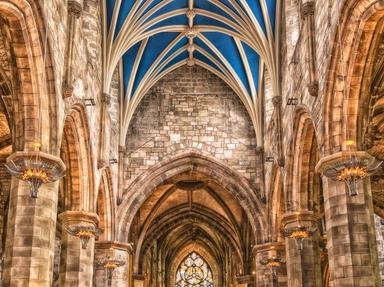Quiz Answer Key and Fun Facts
1. Harmandir Sahib (pictured), which is often referred to as "The Golden Temple" receives more than 100,000 visitors daily. In which country is it located?
2. The ancient city of Bagan dates back to the 9th Century. At its height between the 11th and 13th Centuries, more than 10,000 temples, pagodas and monasteries were constructed on the plains here. More than 2,200 still survive today, and these draw tourist from around the world to which country?
3. The Cathedral of Our Lady of Kazan (pictured), which is also known as Kazan Cathedral, was completely rebuilt in 1993 in the original style. It is now once again one of the most famous landmarks in which national capital?
4. Located on a peninsula on the eastern part of the Pamphylian coast in the Turkish province of Antalya, Side is an ancient city dating back more than 2,000 years. The ruins of the great temple are appropriately seen in the photograph by moonlight. To which ancient God was this and numerous other temples in Greece, Cyprus, Italy and elsewhere in Turkey named?
5. The next stop on our tour takes us to the ruins of another temple named for an ancient God, this time Zeus. Built in the 7th-Century B.C. and once larger than even the Parthenon, the Temple of Zeus at Cyrene is located in which African country?
6. With foundations dating back to the 10th Century (the present structure was built in the 1320s), three mosques, the Sankore Madrasah (pictured), Djinguereber Mosque and Sidi Yahya combined to become one of the first world-class learning institution. Which African city are we visiting?
7. Forty years in the building and dedicated in 1893, the pictured temple is the headquarters of which religious group that includes the singing Osmond family amongst the faithful?
8. Our next stop is at the Mayan Temple of Kukulkan (or El Castillo, Spanish for "the castle"), once part of the large pre-Columbian city of Chichen Itza. To which country must you travel to this spectacular sight?
9. Founded in 1595, Sri Dalada Maligawa or the Temple of the Sacred Tooth Relic is located in the royal palace complex of the former Kingdom of Kandy, a UNESCO World Heritage Site in which country?
10. Built in the early 1600s with six minarets, one main dome and eight secondary domes, the spectacular Sultan Ahmed Mosque (pictured at night) in Istanbul is better known by what colorful name?
Source: Author
EnglishJedi
This quiz was reviewed by FunTrivia editor
stedman before going online.
Any errors found in FunTrivia content are routinely corrected through our feedback system.


